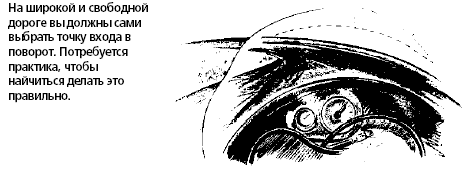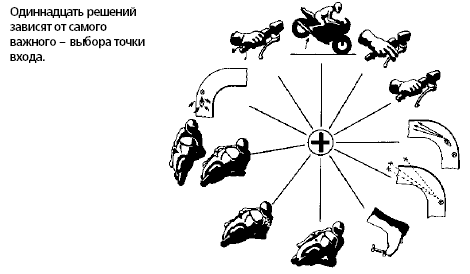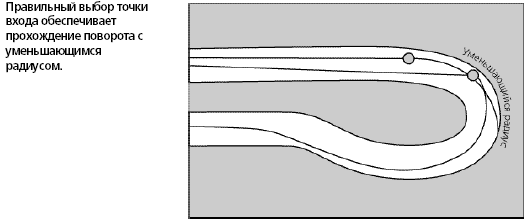|
The chapter 18. Taxiing - three factors of taxiing
The taxiing depends on three factors:
- As far as is fast (we have discussed it above)
- Angle of lean (also have discussed above)
- Where to start (i.e. entry point)
All three factors have limitations imposed as SPI's, and design of a
motorcycle.
If we shall consider the "street" driver, control is high-gravity laden
Gold a Wing on worn trunks, and Dug Chandler, manning the racing motorcycle,
we shall see, that the maiden factor has broad spread of values. You, most
likely, will get somewhere in between them. As a rule, in this case limit is
superimposed mainly SPI's.
The second factor has mechanical limitations. Compare Harley and Suzuki
GSXR - apparently, that maiden will begin to cut scintilla�s in turn, when
second will have a large reserve on angle of lean. However, SPI's here too
play a role, as too strong slope almost for certain will force them to work.
The third factor depends from maiden two. Driver Vulcan-and will wait up
to last to choke bike in turn. The selection of an early entry point almost
is completely instigated SPI's and is the most widespread error.

Where to turn
So, where the turn starts? There, where you start to taxi. Whether you
select an entry point every time, when before you turn? It is necessary to
select. Where you start to taxi, if you have not selected an entry point?
There, where SPI's cause you to make it.
The entry point is a place on on a road, where you start to taxi.
Selection of an entry point - irreplaceable means of strife with SPI's,
working at the approach to turn. And besides, this relevant means of strife
for accuracy and logic nature of operatings. If you have not selected an
entry point, she will appear in a random place. The racers who are taking
chances by selection of an entry point, look on a route unsure, they are
compelled to taxi up in turn and long do not open gas. It is developments
SPI ¹6 (unefficient taxiing).
Acceptance of the main solutions
The entry point always exists, problem only in, whether she is
interpreted is selected. Definition of an entry point - one of the major
solutions, which one you should accept. The remaining solutions, namely
depend on it:

1. Where to begin inhibition.
2. Where to finish inhibition.
3. Where to open gas.
4. Where goes bike, when the desirable angle of lean reachs.
5. Where to leave from turn (as far as is wide).
6. Where to be switch toed under transmission.
7. As far as hardly it is necessary to tilt áàéê.
8. How much taxiings need to be made (and whether they are necessary in
general)
9. As far as it is fast necessary to taxi.
10. what entrance velocity.
11. as far as it is fast necessary to open gas.
See at a list again. As far as these solutions are relevant? Let's, for
example, consider switching to under transmission. If you do it too late,
whether will influence on the termination of inhibition and taxiing? Can
influence. And if you have defined an entry point, ïîìîæåòëè to you it at
definition of the moment, where it is necessary to be toggled? Should help.
Probably, it not the most relevant operating, but it can provoke sequence of
other errors.
To you one more example which is pointing out relevance of selection of
an entry point. This transit of turn with decreasing radius. At an early
entry point you can not correctly accept any of 11 solutions which are
listed above.

There is no ideal for all entry point, she miscellaneous for the
miscellaneous racers. It is better to have though any entry point selected
is interpreted, than to not have it at all. The hint: if you can not apply
in turn a Rule of gas ¹1, means you abnormally have selected an entry point.
Traffic and errors
Traffic and the errors can influence selection of an entry point. However
it is necessary to perceive, that the one who has selected an entry point,
at least perceives, where he is at the moment of turn. The loss of an entry
point allows you immediately to understand, that something is made
abnormally. You, certainly, can understand it and later, but will be more
sick.
Sharpen skill
The selection of an entry point is skill, and as any skill he demands a
digestion. The "street" drivers too are compelled to receive all 11
solutions in each turn. A customary quiet rolling - excellent way to
complete this skill. Do not think, that on low speeds it is possible to
afford to not be precise. And if you can not find an entry point on low
speed, you will trable to make it in rapid motion.
See closely rapid motions of the foremans and pay attention, as far as
they are exact select an entry point. It also distinguishes best from all
other. And it is not important, do l and they it is realized or
instinctively, but their entry point differ on miscellaneous circles all on
some in.s. And so during all rapid motion.
Free attention
Very much often racers attempt to indemnify the errors by increase of
speed, hoping, that "will carry by". Will not carry by, as on a high speed
the probability of an error only increases, you see start to work SPI's.
If you the fan of an epinephrine, you can not select an entry point and
then he to you is ensured. But in this case it is necessary to forget about
improvement of time on a circle. Each abnormally adopted solution actuates
SPI. And each demands a part of your vacant attention. And its quantity, as
we know, is not indefinite.
Selecting and using an entry point you free the attention and can count
your operatings beforehand. And it is not so important, as far as is correct
you it have selected. The "incorrect" entry point is better, than any. She
all the same will liberate your attention.
Each turn has entry point
" As far as is fast " and " as far as hardly " not the most relevant
problems. Most relevant - "where". In Superbike School we mark entry point
to help to the students to experience, what is it such. You should learn to
select an entry point, how shout "Banzay" and put bike in turn, and it is
not important, along the street you go or on a rañing route. It will help to
you to understand, where you are now and where you need to be. The attacking
style in turns degrades outcomes. Rapid motions - smoothly varying thing. If
all is continuous, all means - nice. DG
|